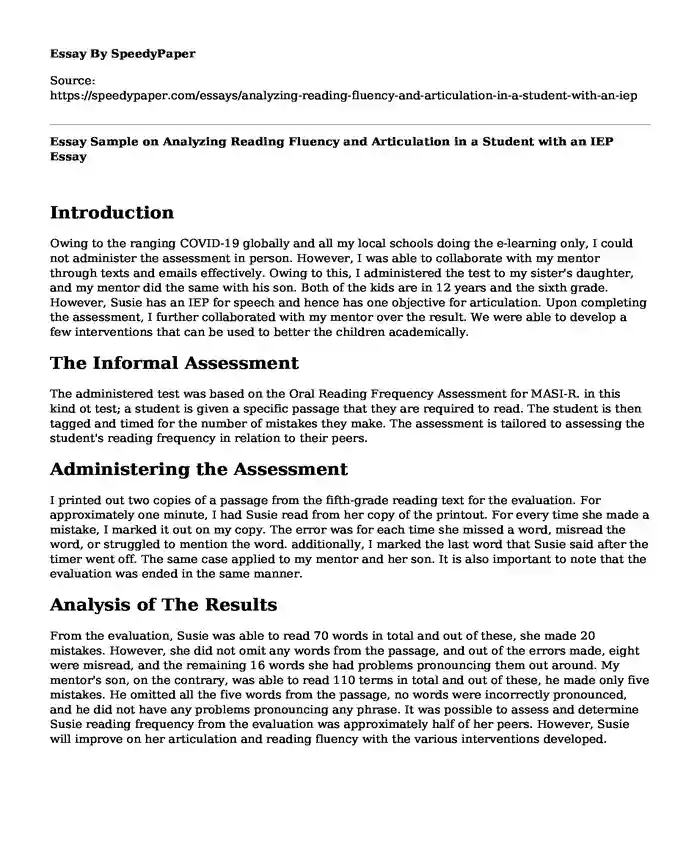
| Type of paper: | Essay |
| Categories: | Education School Healthcare Covid 19 |
| Pages: | 3 |
| Wordcount: | 798 words |
Introduction
Owing to the ranging COVID-19 globally and all my local schools doing the e-learning only, I could not administer the assessment in person. However, I was able to collaborate with my mentor through texts and emails effectively. Owing to this, I administered the test to my sister's daughter, and my mentor did the same with his son. Both of the kids are in 12 years and the sixth grade. However, Susie has an IEP for speech and hence has one objective for articulation. Upon completing the assessment, I further collaborated with my mentor over the result. We were able to develop a few interventions that can be used to better the children academically.
The Informal Assessment
The administered test was based on the Oral Reading Frequency Assessment for MASI-R. in this kind ot test; a student is given a specific passage that they are required to read. The student is then tagged and timed for the number of mistakes they make. The assessment is tailored to assessing the student's reading frequency in relation to their peers.
Administering the Assessment
I printed out two copies of a passage from the fifth-grade reading text for the evaluation. For approximately one minute, I had Susie read from her copy of the printout. For every time she made a mistake, I marked it out on my copy. The error was for each time she missed a word, misread the word, or struggled to mention the word. additionally, I marked the last word that Susie said after the timer went off. The same case applied to my mentor and her son. It is also important to note that the evaluation was ended in the same manner.
Analysis of The Results
From the evaluation, Susie was able to read 70 words in total and out of these, she made 20 mistakes. However, she did not omit any words from the passage, and out of the errors made, eight were misread, and the remaining 16 words she had problems pronouncing them out around. My mentor's son, on the contrary, was able to read 110 terms in total and out of these, he made only five mistakes. He omitted all the five words from the passage, no words were incorrectly pronounced, and he did not have any problems pronouncing any phrase. It was possible to assess and determine Susie reading frequency from the evaluation was approximately half of her peers. However, Susie will improve on her articulation and reading fluency with the various interventions developed.
Student's Feedback
While talking to Susie, she claimed that she does not like reading out around because of her speech disability and said she likes reading silently. Susie claimed further that the results did not surprise her and claimed that she would read at a quicker pace if she read silently. I talked to her mother too about her current situation, and when asked, Susie said that she would like to develop her reading fluency.
Intervention
To improve Susie's reading fluency, we came up with two strategies: echo reading and second strategy is repetitive reading. Echo reading involves the educators reading out around while the student follows along passively. Similarly, the same brief segment involves the student reading about or the student doing the echo reading (Cox, 2019). However, for this intervention, Susie is reading silently while the educator is reading out around to the rest of the class. Through this kind of technique, Susie will be abler to learn taught words while reading the same text as many times as possible, word at a time by the teacher or an adult. The second intervention that would be beneficial for Susie is repetitive reading. A speech-language pathologist or any relative would focus on complex words on a personal basis for this intervention (Kuhn et al., 2006). Therefore, a recommendation with be sent to the parent to work one on one with the student.
Future Professional Practice
From this exercise, I learned that measurement data could have different meanings. For instance, in this assessment, it is deduced that Susie is reading at a relatively slower pace compared to her peers, and this is owing to articulation issues. Therefore, I have realized that the prospective clinical experiment that there is so much that can be learned from a single evaluation. By understanding this, consequently, I will be cautious about the number of assessments that I use on my students and find evaluations that are specifically tailored to specific students and ones that can yield many details.
References
Cox, J. (2019, October 17). Smart Ways to Develop Reading Fluency and Comprehension. https://www.thoughtco.com/developing-fluency-with-repeated-reading-2081398.
Kuhn, M. R., Schwanenflugel, P. J., Morris, R. D., Morrow, L. M., Woo, D. G., Meisinger, E. B., … Stahl, S. A. (2006). Teaching Children to Become Fluent and Automatic Readers . https://journals.sagepub.com/doi/10.1207/s15548430jlr3804_1.
Cite this page
Essay Sample on Analyzing Reading Fluency and Articulation in a Student with an IEP. (2024, Jan 30). Retrieved from https://speedypaper.net/essays/analyzing-reading-fluency-and-articulation-in-a-student-with-an-iep
Request Removal
If you are the original author of this essay and no longer wish to have it published on the SpeedyPaper website, please click below to request its removal:
- Contemporary Society in Application Essay Example
- Free Essay: My Strengths, Weaknesses and Improvements on Academic Writing
- American Sign Language Essay Sample
- Essay Sample on Women in Prison: Who Takes Care of the Children?
- Free Paper Example: Waste Management Lesson Plan
- Essay Sample on Key Elements Impacting the Medicare Legal and Financial Reimbursement Practices
- Reflective Thoughts & Feelings of Nurse Therapist. Essay Example
Popular categories




